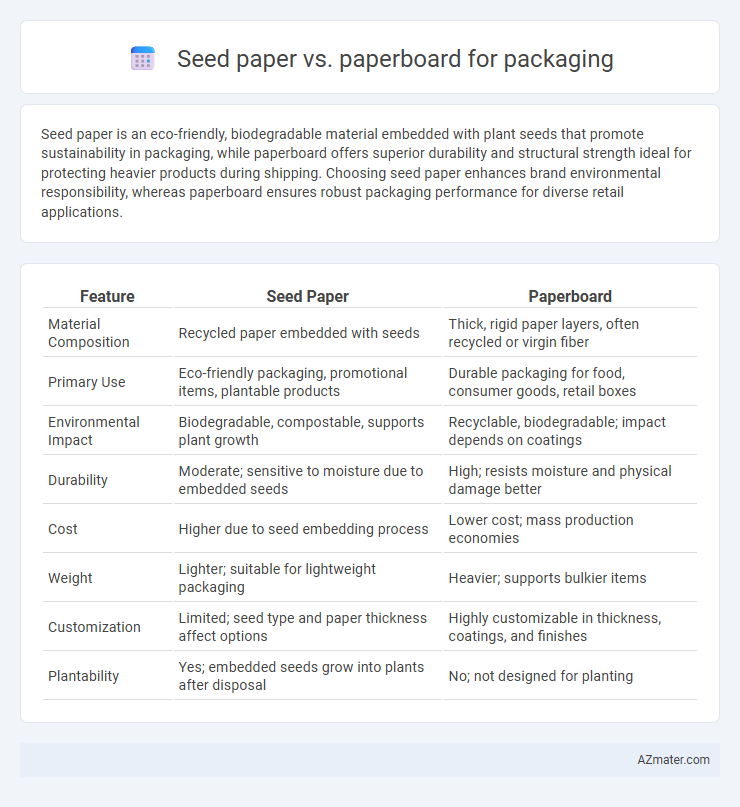Seed paper is an eco-friendly, biodegradable material embedded with plant seeds that promote sustainability in packaging, while paperboard offers superior durability and structural strength ideal for protecting heavier products during shipping. Choosing seed paper enhances brand environmental responsibility, whereas paperboard ensures robust packaging performance for diverse retail applications.
Table of Comparison
| Feature | Seed Paper | Paperboard |
|---|---|---|
| Material Composition | Recycled paper embedded with seeds | Thick, rigid paper layers, often recycled or virgin fiber |
| Primary Use | Eco-friendly packaging, promotional items, plantable products | Durable packaging for food, consumer goods, retail boxes |
| Environmental Impact | Biodegradable, compostable, supports plant growth | Recyclable, biodegradable; impact depends on coatings |
| Durability | Moderate; sensitive to moisture due to embedded seeds | High; resists moisture and physical damage better |
| Cost | Higher due to seed embedding process | Lower cost; mass production economies |
| Weight | Lighter; suitable for lightweight packaging | Heavier; supports bulkier items |
| Customization | Limited; seed type and paper thickness affect options | Highly customizable in thickness, coatings, and finishes |
| Plantability | Yes; embedded seeds grow into plants after disposal | No; not designed for planting |
Introduction to Sustainable Packaging Materials
Seed paper and paperboard represent innovative sustainable packaging materials designed to reduce environmental impact by enhancing biodegradability and recyclability. Seed paper incorporates embedded plant seeds, allowing packaging to be planted after use, promoting a circular lifecycle and reducing landfill waste. Paperboard, typically made from recycled fibers, offers sturdy protection with high recyclability rates and lower carbon footprint compared to traditional packaging materials.
What is Seed Paper?
Seed paper is an eco-friendly material embedded with seeds that can be planted after use, promoting sustainability in packaging. Unlike traditional paperboard, which serves primarily as a protective and structural component, seed paper combines functionality with environmental benefits by encouraging plant growth. This innovative packaging solution reduces waste and supports green initiatives by transforming discarded materials into vibrant plant life.
Understanding Paperboard in Packaging
Paperboard is a thick, durable material widely used in packaging for its strength, versatility, and recyclability. It provides excellent protection and structural support for various products, from food to electronics, while allowing for high-quality printing and branding opportunities. Understanding paperboard's composition, including its layers and coatings, is essential for selecting the right type to meet specific packaging requirements such as moisture resistance or rigidity.
Environmental Impact Comparison
Seed paper offers an eco-friendly alternative to traditional paperboard by embedding biodegradable seeds within recycled fibers, promoting plant growth and reducing landfill waste. Paperboard, while recyclable and biodegradable, typically requires more energy and water during production and lacks the regenerative benefits seed paper provides. Choosing seed paper significantly lowers carbon emissions and supports sustainable packaging initiatives by combining utility with environmental restoration.
Biodegradability and Compostability
Seed paper offers superior biodegradability and compostability compared to traditional paperboard, as it contains embedded seeds that naturally decompose and promote plant growth. Unlike paperboard, which may include coatings or additives that slow down breakdown, seed paper breaks down rapidly in soil, enriching it without leaving harmful residues. This makes seed paper an eco-friendly choice for sustainable packaging, especially in applications prioritizing environmental impact reduction.
Strength and Durability Factors
Seed paper offers moderate strength and durability, designed to biodegrade and promote plant growth, making it suitable for lightweight packaging with environmental benefits. Paperboard provides superior strength and durability, offering rigid support and resistance to moisture and impact, ideal for heavy-duty packaging and long-term protection. Selecting between seed paper and paperboard depends on packaging requirements prioritizing either eco-friendly biodegradability or robust structural integrity.
Printability and Branding Options
Seed paper offers unique branding opportunities with its eco-friendly appeal, featuring a textured surface that can limit detailed print clarity but supports natural, rustic designs ideal for sustainable packaging. Paperboard excels in printability, allowing high-resolution graphics, vibrant colors, and diverse finishing techniques such as embossing, debossing, and spot UV, making it perfect for premium branding and detailed logos. Choosing between seed paper and paperboard depends on whether sustainability or graphic fidelity is prioritized for packaging branding.
Cost Analysis: Seed Paper vs Paperboard
Seed paper typically incurs higher production costs due to embedded seeds and its eco-friendly process, resulting in a premium price compared to conventional paperboard. Paperboard offers cost efficiency through mass production and material availability, making it suitable for large-scale packaging with tighter budget constraints. Evaluating long-term value, seed paper enhances brand sustainability appeal, potentially offsetting upfront expenses through consumer preference and market differentiation.
Ideal Use Cases for Each Material
Seed paper excels in eco-friendly packaging applications where brand sustainability and customer engagement through plantable products are prioritized, such as gift tags, promotional materials, and specialty packaging. Paperboard is ideal for robust packaging needs requiring strength, durability, and print quality, commonly used for food containers, retail boxes, and heavy-duty shipping cartons. Selecting between seed paper and paperboard depends on balancing environmental impact with functional requirements and product protection.
Future Trends in Eco-Friendly Packaging
Seed paper and paperboard represent two pivotal materials in the shift towards sustainable packaging, with seed paper offering biodegradable, plantable options that enhance brand engagement and reduce waste. Future trends highlight increased innovation in seed paper formulations to improve durability and seed germination rates while expanding applications beyond niche markets. Paperboard advancements focus on integrating recycled content, enhancing barrier properties without plastic lamination, and adopting digital printing technologies to minimize environmental impact and promote circular economy practices.

Infographic: Seed paper vs Paperboard for Packaging
 azmater.com
azmater.com